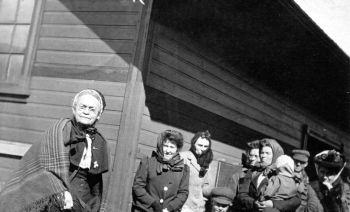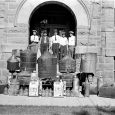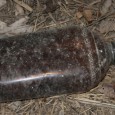The Gift of South Dakota
Subscriptions to South Dakota Magazine make great gifts!
Subscribe today — 1 year (6 issues) is just $29!
Carry Nation’s South Dakota Crusade
In Webster, saloonkeeper Pete Monson hooked a hose to a nearby fire hydrant and announced that he was ready if she came his way. Aberdeen theater manager H.L. Walker said that she had defamed his character and, contract or no contract, she would not appear in his establishment. A Flandreau editor suggested hiring more deputies and arming them with Gatling guns from the state arsenal to prepare for her appearance in that town. In Deadwood, a choir was quickly formed 10 greet and serenade her on her arrival there.
It was December 1909, and the headlines in South Dakota centered on political corruption in Washington and dissent among local Republican leaders. But the talk on the street was of one topic.
Carry Nation was coming!
Carry Amelia Moore was born in Kentucky in 1846. Her father was a temperate, God-fearing farmer. Her mother was something of an eccentric. In fact, Mary Moore believed herself to be Queen Victoria of England. She traveled the Kentucky countryside in a specially built "royal" coach, preceded by a liveried slave blowing a tinhorn to announce her arrival.
Mrs. Moore felt a great and unexplained animosity for her daughter Carry. The mere sight of the young girl sent her into a screaming tirade. It is no surprise then that Carry took the first opportunity to escape her home. In 1867, a few days shy of her 21st birthday, Carry eloped with a local schoolteacher, Dr. Charles Gloyd. Dr. Gloyd was a heavy drinker, but Carry believed that marriage would change him. It did. For five days.
Less than a year after their marriage, a pregnant and disgusted Carry left her drunken husband and returned to her father's home. Dr. Gloyd died in March of 1869, just 16 months after Carry vowed to save him.
Carry supported herself and her daughter by teaching until 1877, when she remarried, this time to a much older man, David Nation, a sometime preacher, lawyer, farmer and newspaper editor. The newlyweds had little in common. They soon separated, and Carry survived by managing inns and hotels in Missouri and Kansas.
She was always heavily involved in church activities. In 1899, while living in Medicine Lodge, Kansas, Carry asked her church to make her a saint. The reason? Her prayers had brought the rains that ended a local drought.
Her request was turned down and Carry went home, locked herself in a basement for three days and studied the Bible. She emerged with renewed spirit and determination. She had been visited with a vision and given a mission. Fired by a combination of her father's temperance, her mother's outrageous flamboyance, and the tragic example of her first husband, she, Carry Nation, would eliminate alcohol from the planet.
Her first stop was the local tavern. She knelt down in the doorway and began to pray. After several days of useless threats and pleas the saloonkeeper locked his doors and moved on.
Buoyed by her success, Carry went to nearby Kiowa, Kansas. Here, perhaps to save her knees, she developed a new technique. Cradling an armful of rocks, she entered Dobson's Saloon and began breaking everything in sight.
The scope of her mission spread across the Kansas borders into neighboring states. A lighter and wieldier hatchet replaced the rock as her saloon-smashing weapon of choice, and the reputation of Carry Nation as a temperance crusader was born.
For the next 10 years Carry's crusade against the demon rum took her across the country and into Canada and Europe. By 1909, her name and her penchant for "hatchetation" were famous, and so, with a Christmas Eve announcement that she was bringing her brand of temperance enlightenment to South Dakota, the state quickly made ready for her tour.
South Dakota in the winter of 1909 and 1910 was ripe for Carry's visit. The prohibition movement was in the midst of one of its periodic upswings, and the debate between "drys" and "wets" was raging in nearly every town and county.
A campaign was in progress over the county option law, which would give voters the choice of outlawing alcohol in their county.
An incident in Pierre shows the heat of the campaign, and perhaps indirectly, Carry's influence, in method if not motive. The president of the Stockgrower’s Bank, a leader in the local prohibition movement, arrived at work to find his office smashed. A suspect, the son of a local tavern owner, was quickly arrested. His weapon? A very unCarrylike beer bottle.
South Dakota had always been ambivalent in its attitude toward alcohol. The state, as admitted to the union, was dry. Liquor sales were banned in its original constitution.
Within a short time the more "civilized" areas of the state, Sioux Falls, Yankton and Deadwood, devised a system of regular monthly fines for illegal liquor distributors or, blind piggers, as they were known; in essence, an operating fee.
In 1896, prohibition as state law was abandoned, but the debate and ambivalence continued. 1910 newspaper ads touted Golden Link Whiskey, "A good top of the morning and a dandy night cap," and Duffy's Pure Malt Whiskey, "To keep young, strong, and vigorous, take Duffy's Pure Malt Whiskey." Those same newspapers bragged that the University of South Dakota was located in Vermillion, ''The Town with No Saloons."
It was into the midst of this debate that the intrepid crusader, Carry Nation, threw herself.
Her first lecture was delivered in Flandreau on Dec. 31, 1909. The crowd was disappointingly small, perhaps due to the rather injudicious date. New Year's Eve celebrants rarely make good temperance lecture audiences. Mrs. Nation was undaunted. She simply carried her message to the streets and hotel lobbies, where she reprimanded the cigar smokers and castigated one man for his red nose, a sure sign of his indulgent lifestyle.
Characteristic of the frantic pace of her entire South Dakota tour, the next day found Carry speaking in Madison. Ignoring the fact that she, like every other woman of 1910, could not vote, Carry announced her preferred candidate for the 1912 presidential elections. She intended to support a Chicago newspaper editor who possessed all the qualities she found preferable in a president.
As for the incumbent, the rotund President Taft, he was a member of a secret order and belonged to the wrong religion. He ate far more than was good for him. "Big Fatty Taft"" was "an unbeliever and an unsafe man." For all that, she found him a great improvement over his predecessor.
From Madison it was on to Watertown, Groton, Egan, Milbank, up to Wahpeton N.D., and back to Aberdeen.
In Aberdeen she had a run-in with the manager of the Gottschalk opera house, where she was scheduled to appear. Carry announced that she was itching to "cut loose on that Godless man, Walker." Mr. Walker's crime, it seems, was in procuring dance bands to perform at his opera house. In Carry's litany of corrupt practices, dancing ranked just below alcohol and tobacco, in a subcategory that included Masons, pool halls, politicians and disrespectful sons-in-law, all of which had caused her problems at one time or another.
Mr. Walker responded by declaring that Carry would not be allowed to appear in his opera house. A later review of her contract, however, convinced him to relent. Or perhaps it was the report in the Aberdeen Daily American that Mrs. Nation had recently returned to her old habit of throwing rocks, a skill she performed "with the speed and accuracy of a professional ball player. It is said she spent all day yesterday practicing up."
Despite the threats and accusations, Carry's visit to Aberdeen passed peacefully. She had long ago learned to ration her outbursts for maximum publicity. And she had learned the politician's trick of never saying never. Every interview began with the observation that, while she had visited many evil, sinful cities in this country, never had she seen one as bad as the one she happened to be in at the time, and concluded with the observation that she never knew just when the spirit might again move her to "hatchetation."
Still, her reputation kept saloon owners nervous. Pete Monson, the Webster barkeeper, was ready with his fire hose when someone shouted that Carry was on her way. A tall figure in a flowing dress entered the door and Pete unleashed the water, sweeping patrons, bottles and the attacker out the door, doing far more damage than Carry Nation ever could. As for Mrs. Nation, she stayed comfortably dry in her hotel room. The would-be saloon smasher was a local practical joker in a woman's dress.
If there was one South Dakota town that truly stood to fear Carry's crusade, it was the wild mining town of Deadwood. She arrived in Deadwood on Jan. 19, and was met by a goodly number of curious well-wishers. Carry remarked that the saloon owners must have been "glad to see me. They were all out in front of their places when I went to the hotel."
The owners of one saloon, the Bodega, may have had a particular interest in Carry's arrival. It was rumored that they had reached a secret agreement with the activist in which she would make a smashing appearance at their saloon, taking care to break only the cheaper bottles and mirrors. Mrs. Nation would get the publicity while the Bodega would enjoy the increased business that such a performance would most certainly draw. The agreement, if it existed, was undone however by a tragic development. The railroad that brought Carry from Rapid City somehow managed to lose her hatchet. Bereft of her ever-present trademark, she was barely able to deliver the evening's lecture. She apologized if the speech lacked her usual fiery style, but she said she was lost and uninspired without her hatchet.
Fortunately, she did not lose her supply of miniature souvenir hatchets. These trinkets were a popular novelty, and every Carry Nation lecture ended with a reminder to the audience that they were on sale in the lobby.
From her disappointing performance in Deadwood, Carry was off to Sturgis, where she was pleasantly surprised by the cordial welcome. Two well-dressed gentlemen called on her at her hotel room. Introducing themselves as leaders in the local anti-saloon movement, they offered to take Mrs. Nation on a sightseeing sleigh ride about town.
Later the mayor of Sturgis called to officially welcome Mrs. Nation. She congratulated him on the fine hospitality accorded her by the community. The mayor was left with the uncomfortable task of informing Carry that the two men with whom she had spent a very visible afternoon were two prominent Sturgis saloonkeepers.
Her lecture tour then took her on to Montana for a short time, after which she returned to South Dakota, with the promise to stay on under the auspices of the state prohibition party until the November elections. It was a promise she was unable to keep.
Carry was 63 years old. She had been following her vision for 10 years, at a pace that would have been difficult for a woman half her age. She was tired and in ill health. She left South Dakota in March for what was to be a brief rest at the small Arkansas home supporters had bought for her. She ventured forth later that summer for a few lectures in nearby towns, but she was weak, her speech slurred and sometimes incoherent.
Carry Nation died in June of 1911. Her South Dakota crusade was her last moment in the spotlight.
Editor’s Note: This story is revised from the January/February 1994 issue of South Dakota Magazine. To order a copy or to subscribe, call (800) 456-5117.










Comments